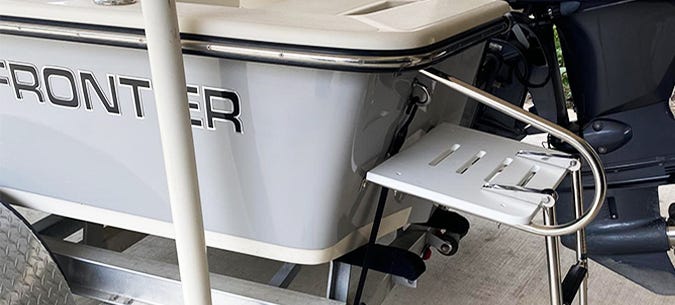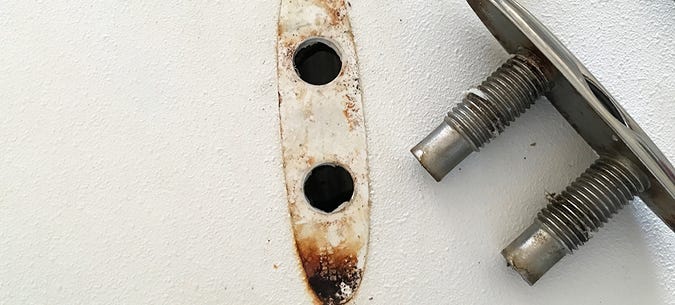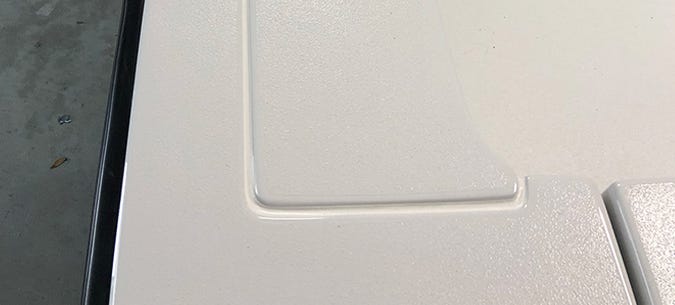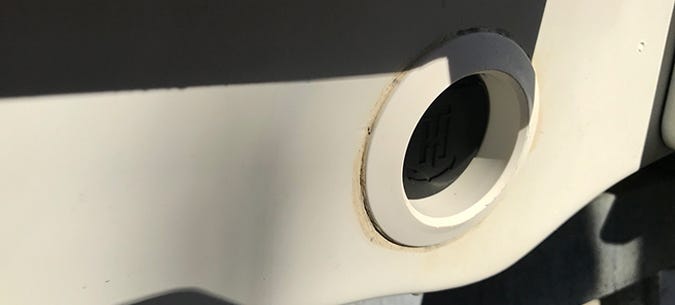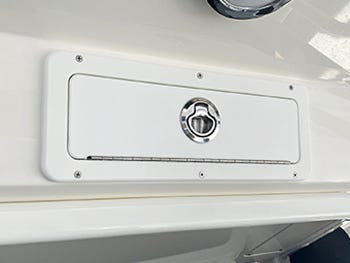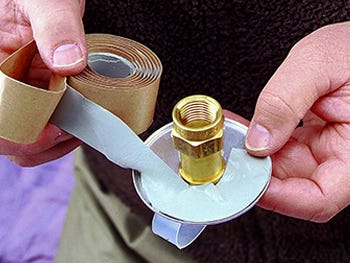

If you’ve ever tried removing a part or accessory that was needlessly installed with 3M 5200, you understand the importance of carefully choosing the right marine sealant for the job. Sure, there are some applications where 5200 is ideal. But there are many, many others where it’s complete overkill.
Contents
- 1. What to Know about Marine Sealants
- 2. How Marine Sealants Are Used
- 2.1 To Seal Holes Through the Hull and Deck
- 2.2 Bedding Deck Hardware and Accessories
- 2.3 Filling or Sealing Joints
- 3. Marine Sealant Properties
- 3.1 Tensile Strength
- 3.2 Durability
- 3.3 UV-resistance
- 3.4 Compatibility with Other Materials
- 4. Types of Marine Sealants
- 4.1 High-Strength Polyurethane Sealants
- 4.2 Lower-Strength Polyurethane Sealants
- 4.3 Polyether Sealants
- 4.4 Polysulfide Sealants
- 4.5 Silicone Sealants
- 4.6 Elastomeric Sealants
- 4.7 Butyl Tape
What to Know about Marine Sealants
The Chuck Norris of marine sealants, 5200 is legendary in DIY boater circles for its strength as an adhesive. Stories circulate about T-tops staying in place for decades attached with nothing but 5200, chunks of fiberglass being ripped out of decks before 5200 would let go. Are they true? Probably not, but there’s no arguing with the fact that high strength polyurethane sealants like 5200 are incredibly tenacious.
Probably because of those legends, 5200 has — unfortunately — become something of a household name and the default sealant for inexperienced DIYers, who use it for everything from mounting electronics brackets to patching holes in hulls (neither of which it should ever be used for, by the way).
The fact is, though, that marine sealants are not one-size-fits-all, or even one-size-fits-most. There are many different types and brands of marine sealants on the market, all of which have specific properties that make them ideal for certain applications and less than ideal for others. There are even a few lesser-known options, like elastomeric sealant and butyl tape, that often work better than the old standbys.
So, before you reach for that tube of 5200 or, worse yet, household silicone caulk, here’s what you need to know about marine sealants.
How Marine Sealants Are Used
Marine sealants are commonly used in few different ways on fiberglass and aluminum recreational boats:
To Seal Holes Through the Hull and Deck
Whenever you cut or drill a hole all the way through your boat — whether it’s for a below-waterline through-hull fitting like a high-speed livewell pickup, an above-waterline through-hull like a bilge pump outlet, or a hatch or window — sealant is used both to keep water from getting into the boat through the opening and to keep water away from the inside of the laminate.
Deck hardware should always be carefully “bedded” in marine sealant to keep water from seeping in. Every hole through your deck or hull should be sealed to prevent water intrusion into the boat and into the laminate itself.
Bedding Deck Hardware and Accessories
Most accessories and hardware you add to a boat require screws or bolts. Sealant should always be used to keep water from seeping into the laminate through those holes. In most cases, accessories or hardware should also be “bedded” in sealant to keep water out from between the hardware and the mounting surface altogether.
Even stainless steel hardware and fasteners are susceptible to rusting from so-called “crevice corrosion” when saltwater is trapped in an oxygen-poor environment.
Filling or Sealing Joints
Marine sealants are also sometimes used to seal joints between parts — the joint between the top of a livewell and the underside of the deck, for example or the joint between console and deck.
Many marine sealants will yellow from UV exposure, making them a poor choice for applications where they’re readily visible and exposed to weather.
Marine Sealant Properties
A few main properties determine which marine sealants are best for which applications:
Tensile Strength
Tensile strength is basically a measure of how well a sealant works as a glue. Some sealants, like 5200, are also powerful adhesives. Others, like silicone, have almost no adhesive properties.
Durability
No marine sealant lasts forever, but some deteriorate more quickly than others with exposure to sun, salt and wear.
UV-resistance
Most quality marine sealants are formulated to resist UV damage, but some are more resistant than others. Also, some sealants that aren’t otherwise damaged by UV still turn yellow in the sun.
Compatibility with Other Materials
Certain sealants play better with certain materials than others. For example, silicone can’t be painted, while polysulfide sealants can melt several common types of plastic.
Types of Marine Sealants
Although there are dozens of different marine sealant products on the market, most fall into one of a few basic categories:
High-Strength Polyurethane Sealants
High-strength polyurethanes, of which 3M 5200 is the best known, offer excellent bonding but are extremely difficult to remove or disassemble. Most, including 5200, yellow in the sun. All can be sanded and painted when fully cured. High-strength polyurethanes are best used for permanent installation of below-waterline through-hull fittings such as raw water pickups and for applications where their strong bonding is beneficial, such as under the feet of T-tops or poling platforms.
Their exceptional strength offers no particular advantage in most above-waterline applications, only creating potential headaches down the road. As a general rule of thumb, if you ever want to take something off, don’t install it with a high-strength polyurethane sealant.
Lower-Strength Polyurethane Sealants
Lower-strength polyurethanes like 3M 4200 Fast Cure and Sikaflex-295 UV still offer plenty of adhesion for the vast majority of jobs but are easier to remove/disassemble than higher-strength polyurethanes. Like higher-strength polyurethanes, they can be sanded and painted when fully cured. Most yellow in the sun, but Sikaflex-295 UV is formulated not to discolor.
Contrary to popular belief, 4200 and most other lower-strength polyurethanes are perfectly suitable for below-waterline use. These are good choices for sealing through-hulls and bedding hardware and accessories like hinges, cleats, and flush-mount rod holders.
Polyether Sealants
Polyethers like 3M 4000UV are more chemical resistant than polyurethanes, compatible with virtually everything, and don’t discolor in the sun. They are also sandable and paintable.
Their adhesive properties are similar to those of the lower-strength polyurethanes; in other words, removal/disassembly is difficult but not impossible. Polyethers can be used above and below waterline.
They are an especially good choice for bedding and sealing in visible areas where discoloration is undesirable.
Polysulfide Sealants
Polysulfides like BoatLife Life-Calk are weaker adhesives than polyurethanes or polyethers, which is an advantage for many applications.
Like polyethers, they are extremely resistant to oils, cleaners and other chemicals and can be sanded and painted when cured. They attack most plastics, though, including acrylic/Plexiglass, Lexan, and ABS and are harder and less flexible when cured than other sealants.
Silicone Sealants
Although they are widely used, even marine-formulated silicone sealants are rarely the best choice. Their primary advantages are that they are chemical resistant and safe to use with all plastics. They are best used to form “gaskets” around hatch lenses and windows.
Silicone cannot be sanded or painted and tends to deteriorate quickly and look ragged. It also leaves a slippery residue when removed that nothing else will stick to — even new silicone.
Elastomeric Sealants
Less well known than polyurethanes or silicones, elastomeric sealants like Sudbury Elastomeric Sealant offer significantly lower tensile strength, making them excellent choices for bedding hardware that may need to be removed. They are extremely UV-stable, suitable for use below the waterline, easy to apply and clean up, retain their flexibility when cured, and can be sanded and painted.
Additionally, although no marine sealant adheres strongly to King Starboard and other polyethylene materials, elastomeric sealants do so better than anything else. Boat Outfitters recommends elastomeric sealant for use with both Starboard and acrylic accessories and parts.
Butyl Tape
Butyl tape comes, as the name suggests, in a roll rather than a tube. It has essentially zero tensile strength, which means removal/disassembly is easy.
About the consistency of chewing gum or plumber’s putty, butyl tape remains pliable indefinitely rather than curing, is compatible with all plastics, resists UV, and, maybe best of all, is mess-free and requires no masking for installation.
You simply apply the tape where you want it and then trim off any excess. Butyl tape is not suited for below-waterline use, nor for applications where bonding is desirable, but it’s an excellent choice for bedding deck hardware.

